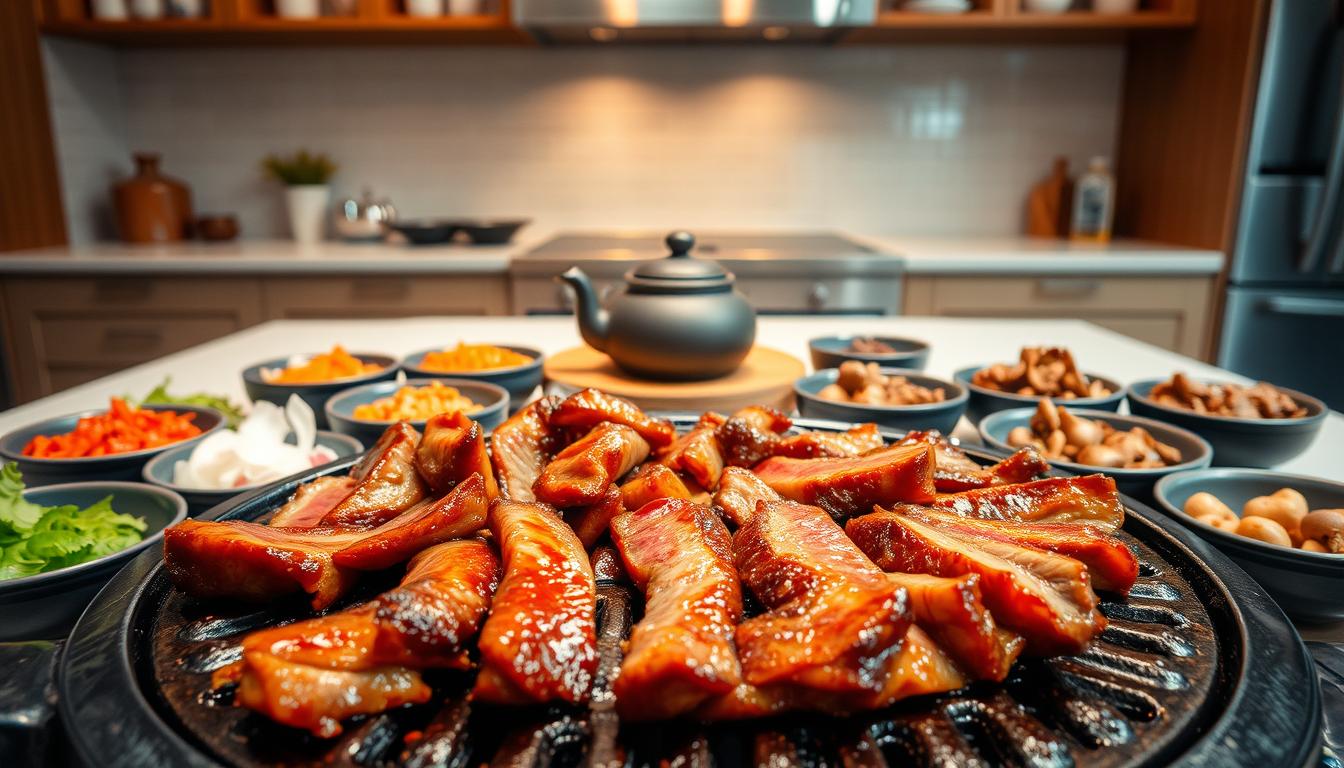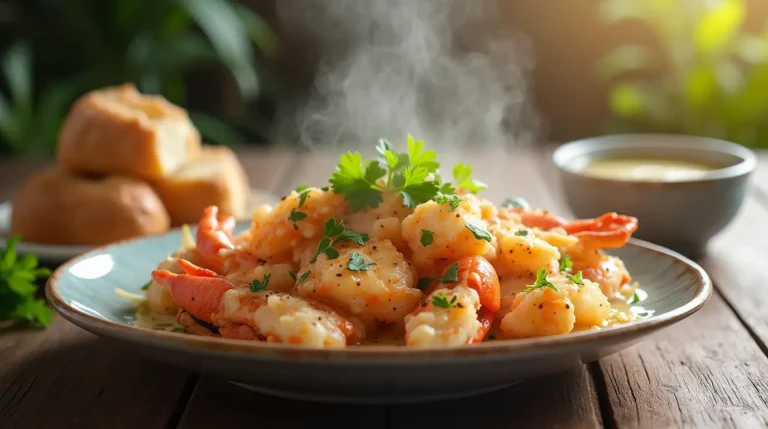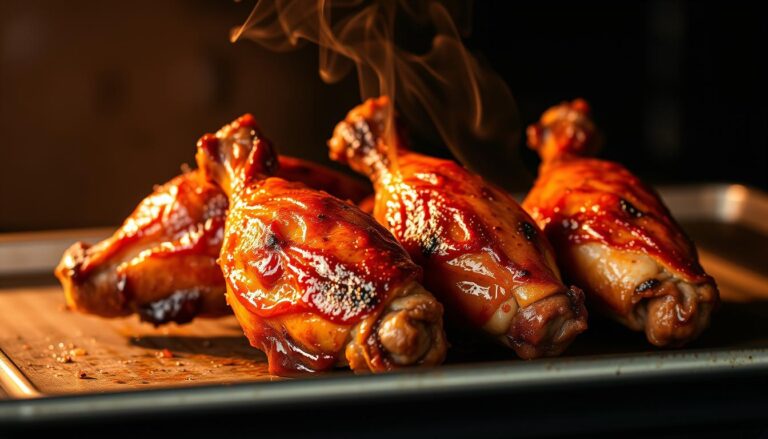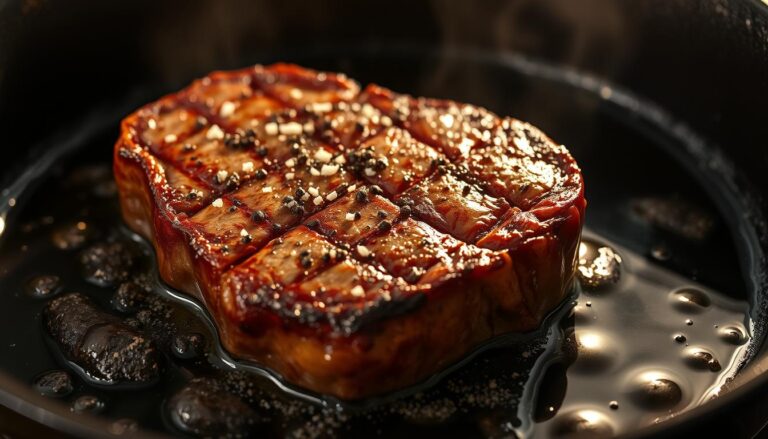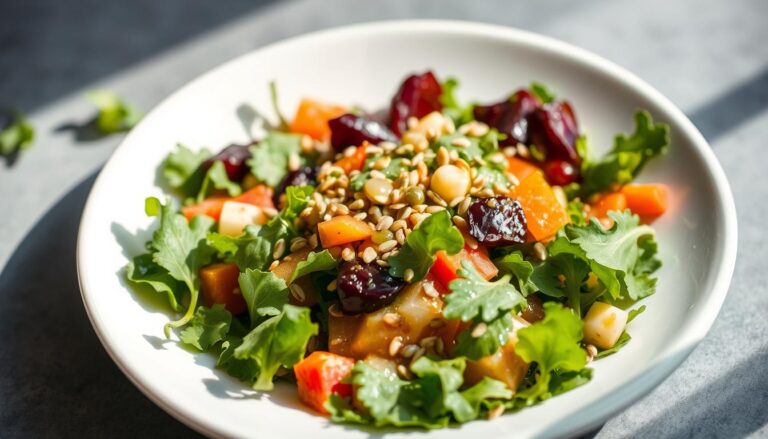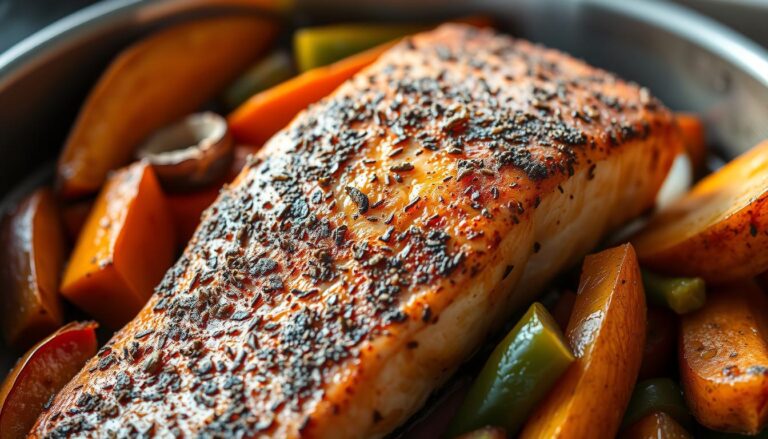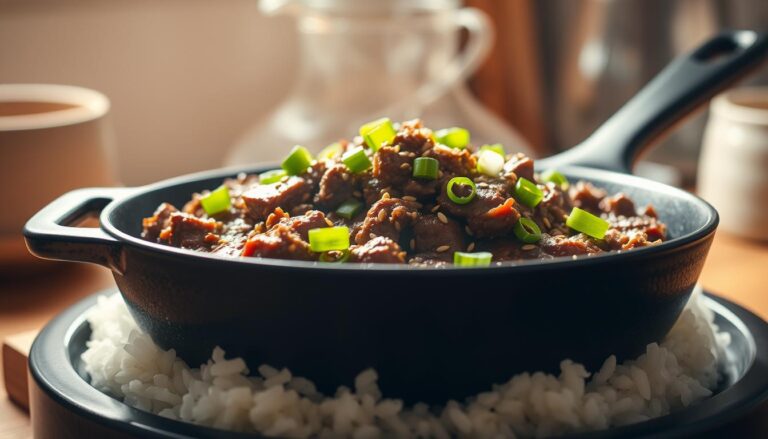Easy Bulgogi Recipe | Make Korean BBQ at Home
The first time I tasted bulgogi, it was like discovering a culinary secret. It changed my home cooking forever. This Korean BBQ dish is more than just a meal. It’s an experience that brings warmth, flavor, and culture to your kitchen.
Making an easy bulgogi recipe at home is not just about cooking. It’s about connecting to a rich culinary tradition. Imagine bringing the vibrant tastes of Korean BBQ to your dining table. You don’t need to visit a restaurant.
With this homemade bulgogi recipe, you’ll unlock the magic of tender, marinated beef. It melts in your mouth and fills your kitchen with an irresistible aroma. Whether you’re a cooking novice or a seasoned chef, this guide will help you master the art of Korean BBQ at home.
Table of Contents
Understanding Korean Bulgogi Recipe: A Traditional BBQ Dish
Traditional Korean BBQ is a journey into Korean cuisine. Bulgogi is a key dish that shows the heart of Korean cooking. It’s a mix of flavors and culture.
The history of bulgogi recipe goes back centuries to the Goguryeo era of Korea. It was once a luxury for royals and the wealthy. Now, it’s a favorite dish for everyone.
Origins and Cultural Significance
Korean BBQ is more than food; it’s a way to connect with others. The way it’s prepared shows deep cultural ties:
- Started from maekjeok, an ancient grilled meat dish
- Evolved during the Joseon Dynasty
- Represents hospitality and community sharing
What Makes Bulgogi Special
Bulgogi is special because of its unique preparation. It involves:
- Thinly sliced beef
- Marinating in a sweet and savory sauce
- Grilling to perfection
The flavor of bulgogi is what makes it stand out. It has a perfect mix of sweet, salty, and umami tastes.
| Characteristic | Description |
|---|---|
| Meat Cut | Sirloin or tenderloin |
| Marination Time | 30 minutes to 4 hours |
| Cooking Method | Grilling or pan-frying |
Bulgogi is more than a dish; it’s a symbol of Korean culture. It shares its rich flavors with people all over the world.
Essential Ingredients for Authentic Bulgogi
To make authentic bulgogi, you need the right ingredients. Your Korean marinade is key. It turns simple meat into a tasty dish.
The main ingredients for traditional bulgogi are:
- Beef: Usually sirloin or rib-eye, thinly sliced
- Soy sauce – the base of Korean marinade
- Sesame oil for a deep, nutty flavor
- Garlic and ginger for a strong aroma
- Brown sugar or Asian pear for sweetness
- Green onions for a fresh garnish
Special ingredients that add to the authentic Korean taste are:
- Mirin (sweet rice wine)
- Gochugaru (Korean red pepper flakes)
- Toasted sesame seeds
“The secret to great bulgogi lies not just in the ingredients, but in understanding their harmonious balance.” – Korean Culinary Tradition
When you shop, choose fresh, quality ingredients. Asian grocery stores have what you need for traditional Korean cooking. If you can’t find something, you can use substitutes. This way, you won’t lose the dish’s true taste.
Choosing and Preparing the Right Cut of Beef
Choosing the right beef for bulgogi is key to a great Korean BBQ. The cut affects the meat’s tenderness, flavor, and quality. Knowing how to prepare and slice the meat is essential for a tasty meal.
- Sirloin: Offers excellent flavor and tenderness
- Rib-eye: Provides rich marbling and juiciness
- Tenderloin: The most tender option for slicing meat for bulgogi
Expert Slicing Techniques
Start with precise cutting for perfect bulgogi. Slice the beef against the grain into thin, even pieces. Aim for slices about 1/8 inch thick for quick cooking and full flavor.
Freezing the meat for 30-45 minutes before slicing helps. It makes cutting thin, even slices easier and keeps the meat intact.
Preparation Tips for Perfect Bulgogi
Good beef preparation can make your bulgogi stand out. Here are some tips:
- Choose fresh, high-quality beef with minimal connective tissue
- Use a sharp knife for clean, precise cuts
- Remove any excess fat to prevent tough texture
Remember, the key to exceptional bulgogi lies in selecting the right cut and mastering your slicing technique.
Easy Bulgogi Recipe: Step-by-Step Instructions
Making bulgogi at home is easier than you think. This simple Korean BBQ recipe turns your kitchen into a Korean food paradise. Just follow these easy steps to make a delicious, authentic dish.
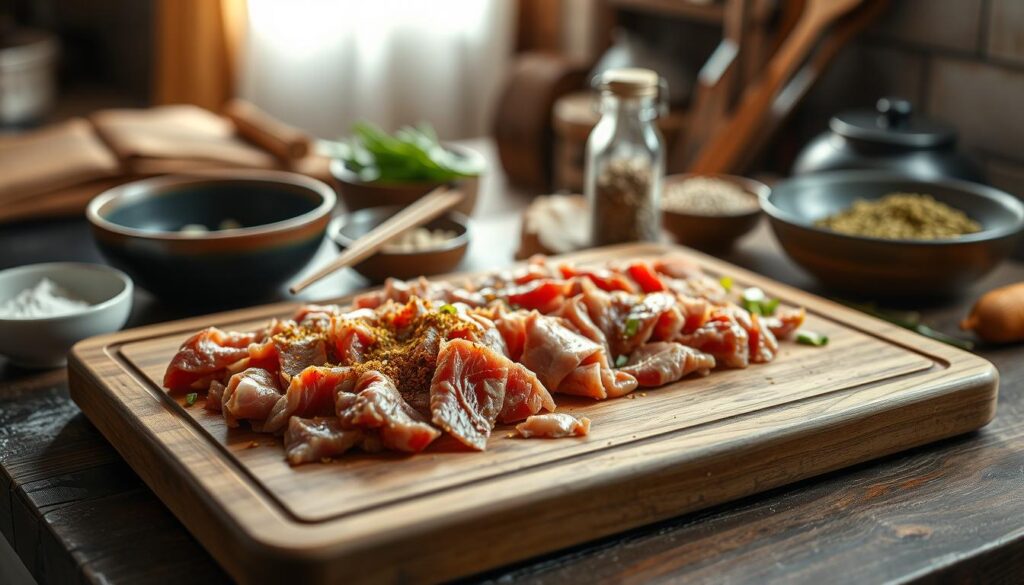
- Slice beef ultra-thin against the grain (about 1/8 inch thick)
- Mix marinade ingredients in a large bowl
- Coat beef slices thoroughly with marinade
- Let meat marinate for 30 minutes to 2 hours
- Preheat grill or heavy skillet to high heat
- Cook meat in small batches for 2-3 minutes
- Serve immediately with steamed rice
Pro tip: Don’t overcrowd the cooking area. Cooking in small batches helps each slice get perfectly caramelized and stay tender.
The secret to great bulgogi is finding the right mix of sweet, savory, and charred flavors. With a bit of practice, you’ll make Korean BBQ as good as a restaurant’s in your own kitchen.
Making the Perfect Bulgogi Marinade
Making a great bulgogi marinade is key to turning regular beef into a delicious Korean BBQ dish. The right mix of ingredients can take your dish from good to amazing.
Your marinade is the heart of bulgogi. It adds rich, complex flavors that make this Korean dish so loved. Learning the right marinating techniques will help you get restaurant-quality results at home.
Traditional Marinade Components
A traditional Korean BBQ sauce for bulgogi includes these main ingredients:
- Soy sauce – gives a deep umami flavor
- Asian pear juice – adds sweetness and tenderizes the meat
- Garlic – adds a strong aromatic taste
- Sesame oil – adds a nutty flavor
- Brown sugar – balances the savory flavors
- Grated ginger – adds a subtle warmth
Marination Time and Techniques
Getting the marinating techniques right can greatly improve your bulgogi’s taste and texture. Aim to marinate your beef for:
- Minimum: 30 minutes
- Optimal: 2-4 hours
- Maximum: Overnight (8-12 hours)
Pro tip: Always marinate in a non-reactive container and refrigerate to prevent bacterial growth. Make sure the meat is fully covered by the marinade for even flavor.
Cooking Methods and Equipment Needed
Cooking bulgogi at home needs the right tools and skills. Whether you love Korean BBQ or want to try new dishes, knowing the best ways to cook is key. It helps you make a meal that tastes just like it’s from Korea.
There are many ways to cook bulgogi, turning your kitchen into a Korean BBQ spot:
- Traditional Korean Tabletop Grill: The most authentic way to cook bulgogi
- Cast Iron Skillet: Great for getting a perfect sear
- Bulgogi Grill Pan: Made just for Korean BBQ cooking
- Outdoor Grill: Adds a smoky taste to your meat
If you don’t have special gear, a regular non-stick skillet works well. The trick is to cook the beef fast over high heat. This keeps it tender and full of flavor.
Think about these things when choosing how to cook:
- What kitchen tools you have
- The flavor you want
- How long you want to cook and how easy it is
A bulgogi grill pan is a great buy for those serious about Korean BBQ at home. These pans have a ridged surface. It helps get rid of extra fat and makes nice grill marks.
Pro tip: No matter your cooking method, always cut the meat thinly. Also, don’t put too much in the pan at once for the best results.
Serving Suggestions and Side Dishes
Creating the perfect Korean BBQ experience is more than just cooking bulgogi. The right side dishes and Korean BBQ accompaniments can make your meal unforgettable. Knowing how to pair your main dish will make your meal better and impress your guests.
Traditional Korean cuisine has many sides that make bulgogi stand out. These sides are not just extras but key parts of the meal. They balance flavors and textures.
Traditional Korean Accompaniments
- Kimchi: The quintessential fermented vegetable side that adds tangy spiciness
- Banchan: Small side dishes like pickled radishes and seasoned vegetables
- Steamed rice: A perfect base for absorbing bulgogi’s rich marinades
- Lettuce wraps: For creating traditional Korean-style meat parcels
Modern Fusion Bulgogi Recipes and Combinations
For those who want to try something new, fusion bulgogi recipes are exciting. You can turn traditional bulgogi into innovative dishes. These dishes mix Korean flavors with international cuisines.
| Fusion Style | Dish Description |
|---|---|
| Korean Bulgogi Tacos | Bulgogi meat in soft tortillas with kimchi slaw |
| Bulgogi Pizza | Korean-style pizza topped with marinated beef and green onions |
| Bulgogi Burger | Beef patty with traditional Korean marinades and Asian slaw |
Pro tip: When serving bulgogi, offer multiple side dishes for a balanced Korean dining experience. The goal is variety and flavors that complement your main dish.
Storage Tips and Meal Prep Ideas
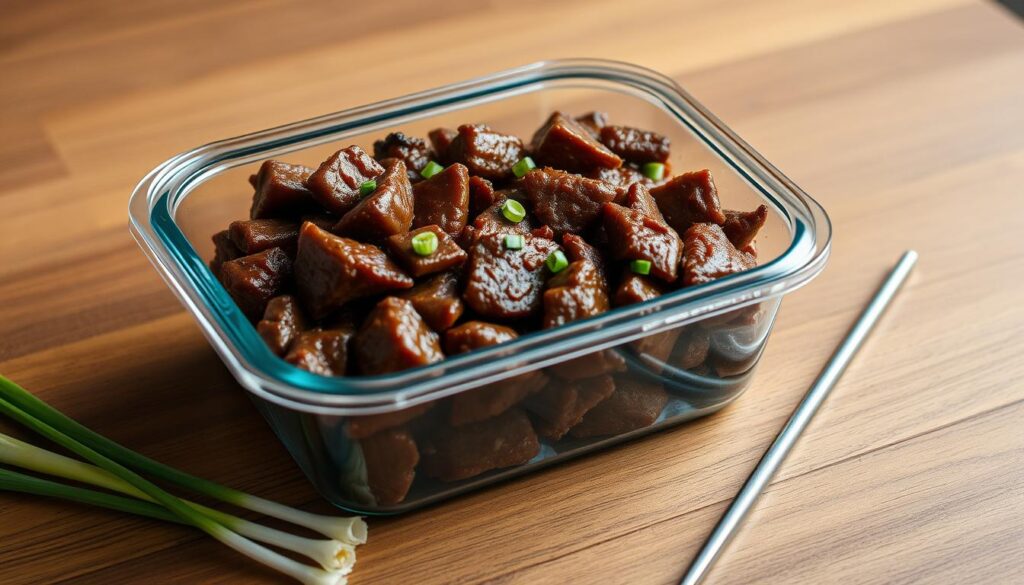
Learning how to store bulgogi is crucial for enjoying it long after the first meal. The right storage methods can keep your Korean BBQ tasty and fresh for longer.
Here are some key tips for bulgogi meal prep:
- Refrigerate cooked bulgogi within two hours of cooking
- Store in airtight containers to maintain freshness
- Consume refrigerated bulgogi within 3-4 days
To keep bulgogi fresh, cool it down completely before storing. Keep the meat and sauces or side dishes separate to avoid sogginess. Pro tip: Store in portion-sized containers for easy reheating.
Reheating leftover Korean BBQ needs gentle care. Here’s how to make it taste like new:
- Microwave with a damp paper towel to retain moisture
- Reheat in a skillet on medium-low heat
- Add a splash of water or broth to prevent drying
Get creative with your leftover bulgogi. Turn it into bulgogi tacos, bulgogi fried rice, or bulgogi-topped salads. These ideas will make your leftovers into quick, tasty meals.
Common Mistakes to Avoid When Making Bulgogi
Perfecting homemade bulgogi needs careful attention and knowledge of common mistakes. Many home cooks face challenges in making authentic Korean BBQ. By knowing and fixing these mistakes, you can improve your cooking and wow your guests.
When making bulgogi, several key errors can ruin your dish. It’s important to know these mistakes to get that perfect Korean BBQ taste.
Top Bulgogi Cooking Mistakes to Avoid
- Incorrect Meat Slicing: Cutting meat too thick or unevenly prevents proper marinade absorption and even cooking
- Over-Marinating: Leaving meat in marinade too long can break down protein fibers, resulting in mushy texture
- High Heat Cooking: Burning meat instead of achieving a perfect caramelized exterior
- Skipping Meat Tenderization: Failing to use techniques that ensure soft, tender bulgogi
Expert Korean BBQ Tips for Success
| Mistake | Solution |
|---|---|
| Tough Meat | Slice against grain, use Asian pear in marinade |
| Bland Flavor | Balance soy sauce, sugar, and sesame oil precisely |
| Uneven Cooking | Use high heat, cook in batches, don’t overcrowd pan |
Mastering bulgogi takes practice. Focus on each step, from choosing meat to plating. Your dedication to these Korean BBQ tips will make your home-cooked meals amazing.
Conclusion
Learning to make bulgogi is more than just a recipe. It’s diving into the rich flavors of Korean cooking at home. This journey begins with a delicious Korean BBQ dish that turns simple ingredients into a feast.
You now have the skills to make restaurant-quality bulgogi in your kitchen. The recipe’s beauty is in its flexibility. You can change the marinade, try different meats, and make it your own.
Cooking is a journey of discovery and creativity. Every time you make bulgogi, you get better and appreciate Korean cooking more. Don’t be shy to add your own twist—start with the basics and follow your taste.
We encourage you to share your bulgogi stories, photos, and creative ideas. Your kitchen is a doorway to Korean cuisine. Start grilling, explore, and enjoy your homemade bulgogi!
FAQ
What is the best cut of beef for bulgogi?
Can I make bulgogi if I don’t have a traditional Korean grill?
How long should I marinate the beef?
Is bulgogi gluten-free?
Can I freeze bulgogi marinade or prepared meat?
What are traditional side dishes to serve with bulgogi?
Can I make bulgogi with a different type of meat?
How do I get the most flavor when making bulgogi?
We’d Love to Hear Your Sweet Feedback!
There are no reviews yet. Be the first one to write one.

